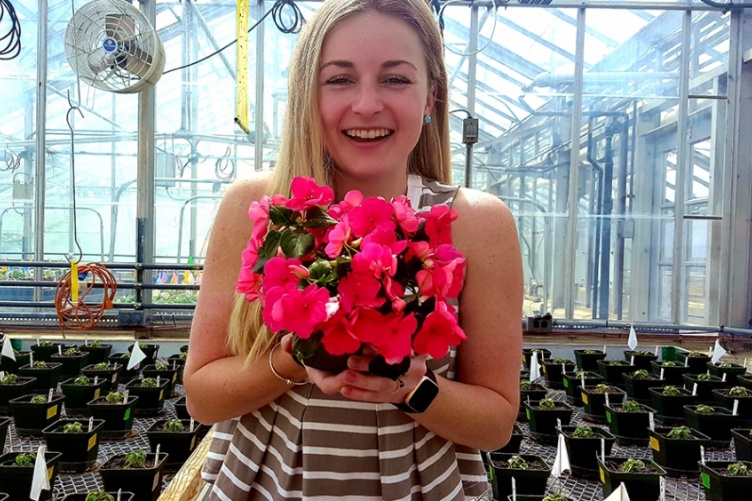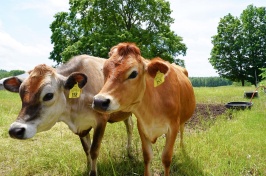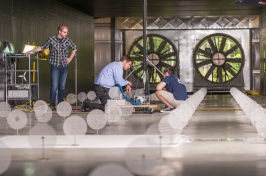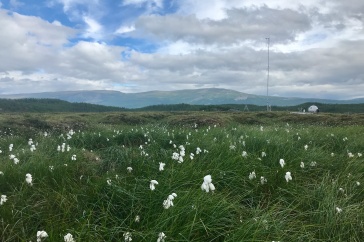
Crysta Harris, ’19G.

when grown in peat-based substrates amended with 30 percent, by
volume, pine tree materials or a commercial wood fiber product. However,
plant performance such as leaf greenness and flower number per plant
were not significantly affected by the substrate treatments
Increasing transportation costs, concerns over the environmental sustainability of peat harvesting processes, and occasional shortages of peat and perlite have increased the
need for alternative growing materials, which are called substrates, for ornamental plant growers. New research from the University of New Hampshire shows amending traditional soilless substrates with pine wood fiber has great potential as an alternative material for the state’s floriculture industry.
“Before reaching the garden center, ornamental plants such as flowers and bedding plants are typically grown in containers in large greenhouses. When plants are grown in containers, the containers are filled with a soilless substrate. This substrate is soilless because it rarely contains actual mineral soil, especially when these plants are grown in a greenhouse,” said Crysta Harris, ’19G. She conducted her research under the guidance of NH Agricultural Experiment Station researcher Anissa Poleatewich, assistant professor of plant pathology at UNH, and Ryan Dickson, formerly at UNH who now is at the University of Arkansas.
Soilless substrates for greenhouse plant production are mostly made up of a combination of materials such as peat moss, bark, and perlite. Increasing transportation costs and occasional shortages of peat and perlite have increased the need for alternative substrate materials. Wood products show great potential to enhance traditionally used materials.
“Wood fiber materials have been used in Europe since the 1980s, and they are gaining market share among North American floriculture operations. Researchers have found that wood fiber can enhance certain peat mixes due to its unique properties. However, there are many considerations and possible drawbacks growers need to consider before incorporating these materials into their substrates,” said Harris, whose research took place at the experiment station’s Macfarlane Research Greenhouses.
Specifically, Harris investigated potential issues that greenhouse growers might encounter such as plant performance, plant nitrogen requirements, and the substrates’ ability to buffer against pH changes, all of which are crucial aspects of containerized plant production.

used in Europe since the 1980s,
and they are gaining market share
among North American floriculture
operations.
She found that container-grown petunia plants experienced a slight growth reduction when grown in peat-based substrates amended with 30 percent, by volume, pine tree materials or a commercial wood fiber product. However, plant performance such as leaf greenness and flower number per plant were not significantly affected by the substrate treatments.
“This research shows the feasibility of amending soilless substrates with about 20 to 40 percent wood fiber, by volume, without drastic effects on plant performance or the need to change any major cultural growing practices. Results from this work show that surpassing a 40 percent incorporation rate negatively affects plant performance. This reduction in plant growth is potentially the result of physical properties, pH buffering, or the presence of phytotoxic compounds present in the material,” said Harris who now is a greenhouse grower at Cavicchio Greenhouses in Sudbury, Mass.
According to the 2017 U.S. Census of Agriculture, sales for New Hampshire’s floriculture and bedding crop industry are $32.9 million.
This research is presented in the journal HortTechnology in the article “Evaluating Peat Substrates Amended with Pine Wood Fiber for Nitrogen Immobilization and Effects on Plant Performance with Container-Grown Petunia” (DOI: https://doi.org/10.21273/HORTTECH04526-19).
Collaborators include Poleatewich, Ryan Dickson at the University of Arkansas, Brian Jackson at North Carolina State University and the North Carolina State University Horticultural Substrates Laboratory, NH Agricultural Experiment Station researcher Rebecca Sideman, and Paul Fisher at the University of Florida and the Floriculture Research Alliance. Materials for this project were provided by Pleasant View gardens, Profile Products, LLC, Pindstrup, and Klasmann-Dihlmann.

Hampshire’s floriculture and bedding crop industry are $32.9 million.
This material is based upon work supported by the NH Agricultural Experiment Station, through joint funding of the National Institute of Food and Agriculture, U.S. Department of Agriculture, under award number 1016530, and the state of New Hampshire.
Founded in 1887, the NH Agricultural Experiment Station at the UNH College of Life Sciences and Agriculture is UNH’s original research center and an elemental component of New Hampshire's land-grant university heritage and mission. We steward federal and state funding, including support from the USDA National Institute of Food and Agriculture, to provide unbiased and objective research concerning diverse aspects of sustainable agriculture and foods, aquaculture, forest management, and related wildlife, natural resources and rural community topics. We maintain the Woodman and Kingman agronomy and horticultural research farms, the Macfarlane Research Greenhouses, the Fairchild Dairy Teaching and Research Center, and the Organic Dairy Research Farm. Additional properties also provide forage, forests and woodlands in direct support to research, teaching, and outreach.
The University of New Hampshire is a flagship research university that inspires innovation and transforms lives in our state, nation and world. More than 16,000 students from all 50 states and 71 countries engage with an award-winning faculty in top ranked programs in business, engineering, law, liberal arts and the sciences across more than 200 programs of study. UNH’s research portfolio includes partnerships with NASA, NOAA, NSF and NIH, receiving more than $100 million in competitive external funding every year to further explore and define the frontiers of land, sea and space.
-
Written By:
Lori Tyler Gula, Ph.D., '19 | NH Agricultural Experiment Station | lori.gula@unh.edu | 603-862-1452



















































